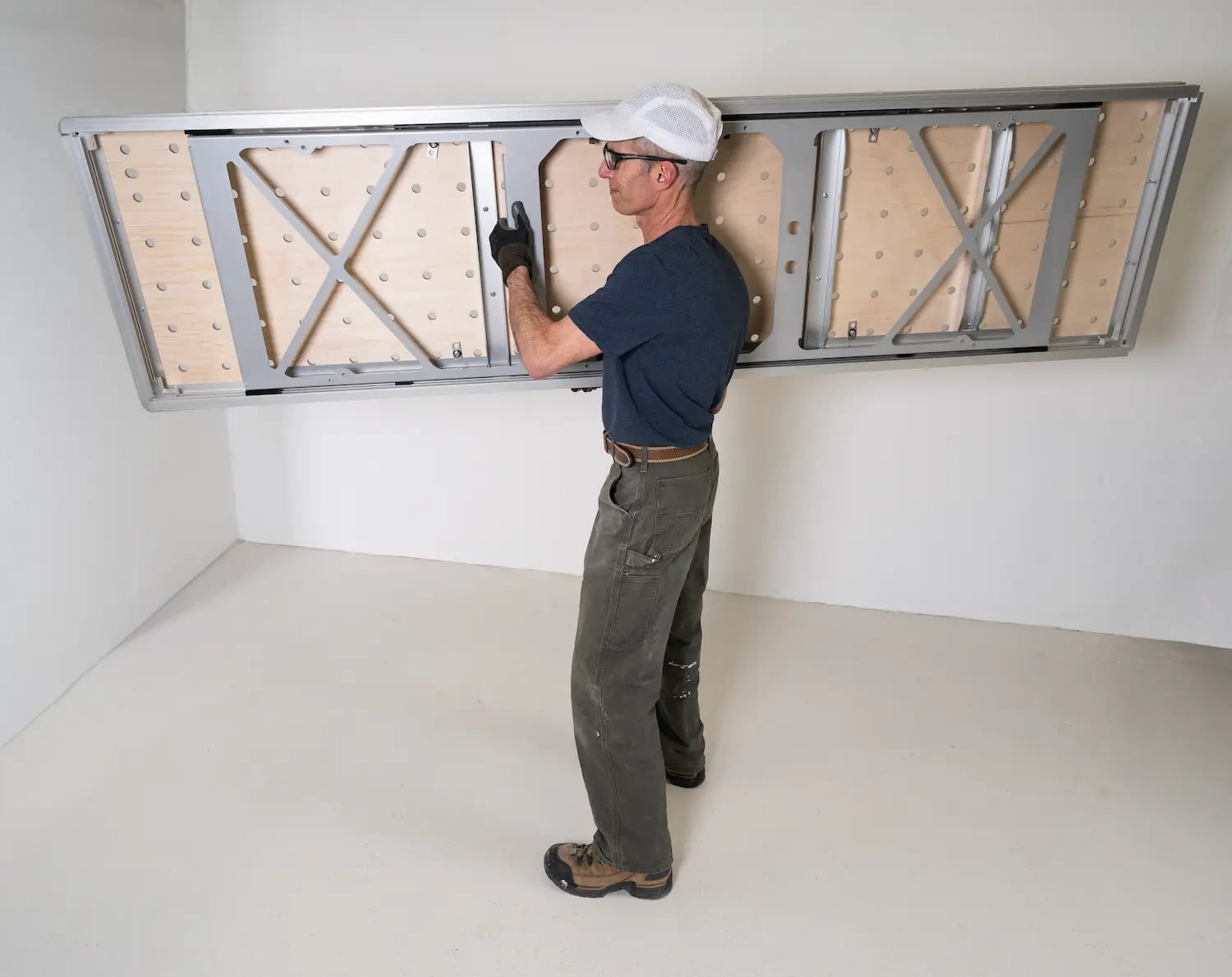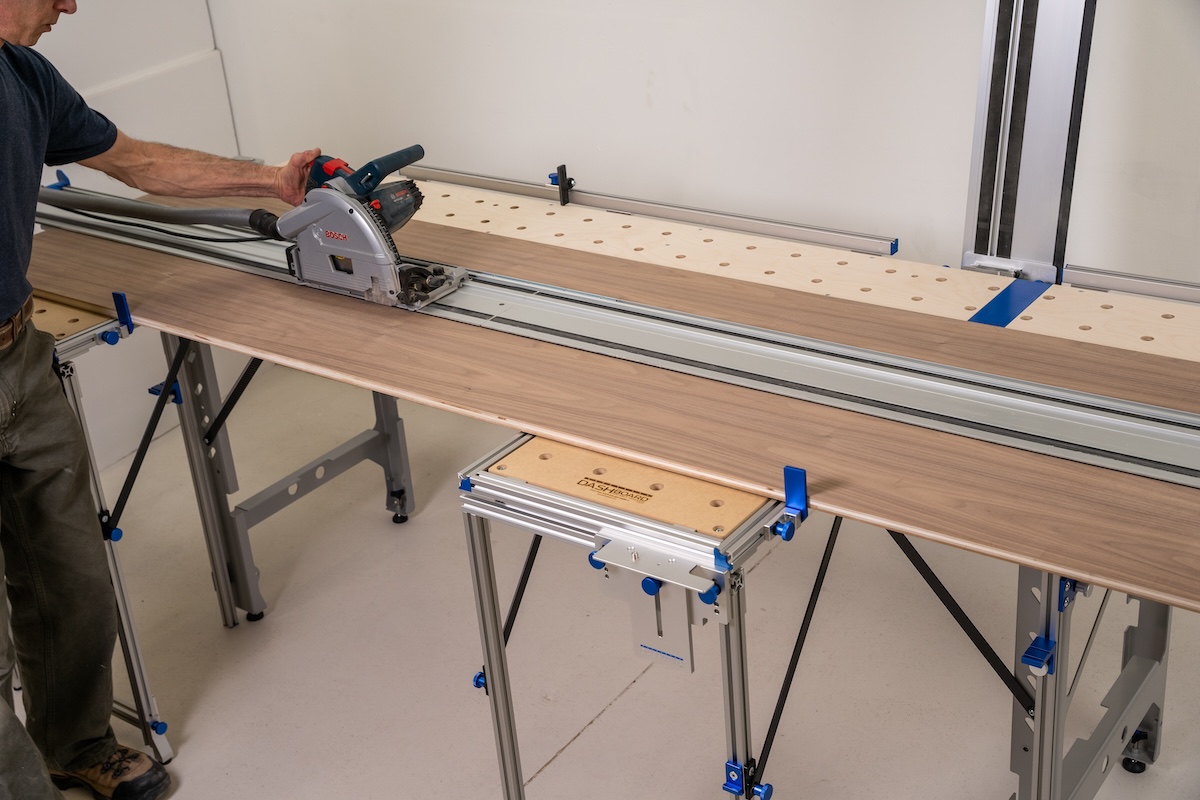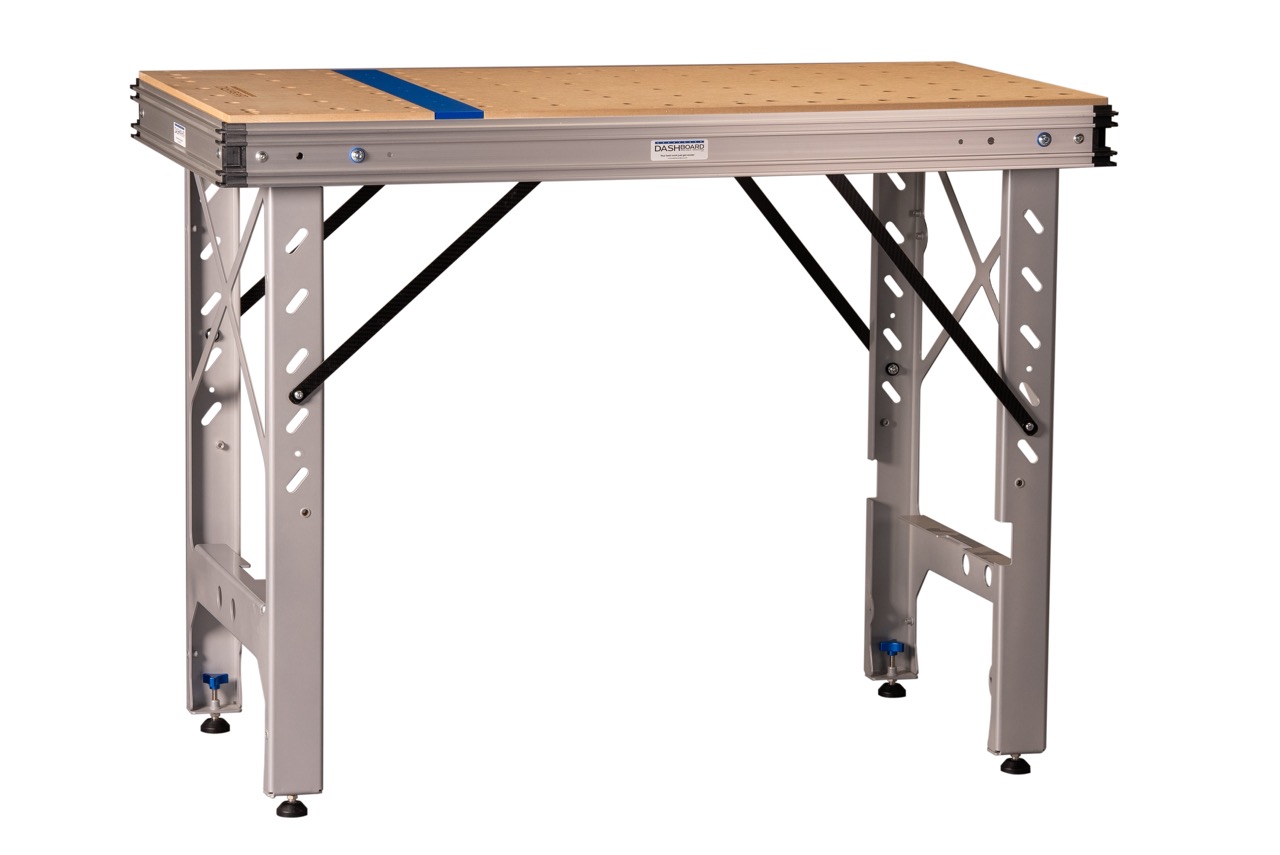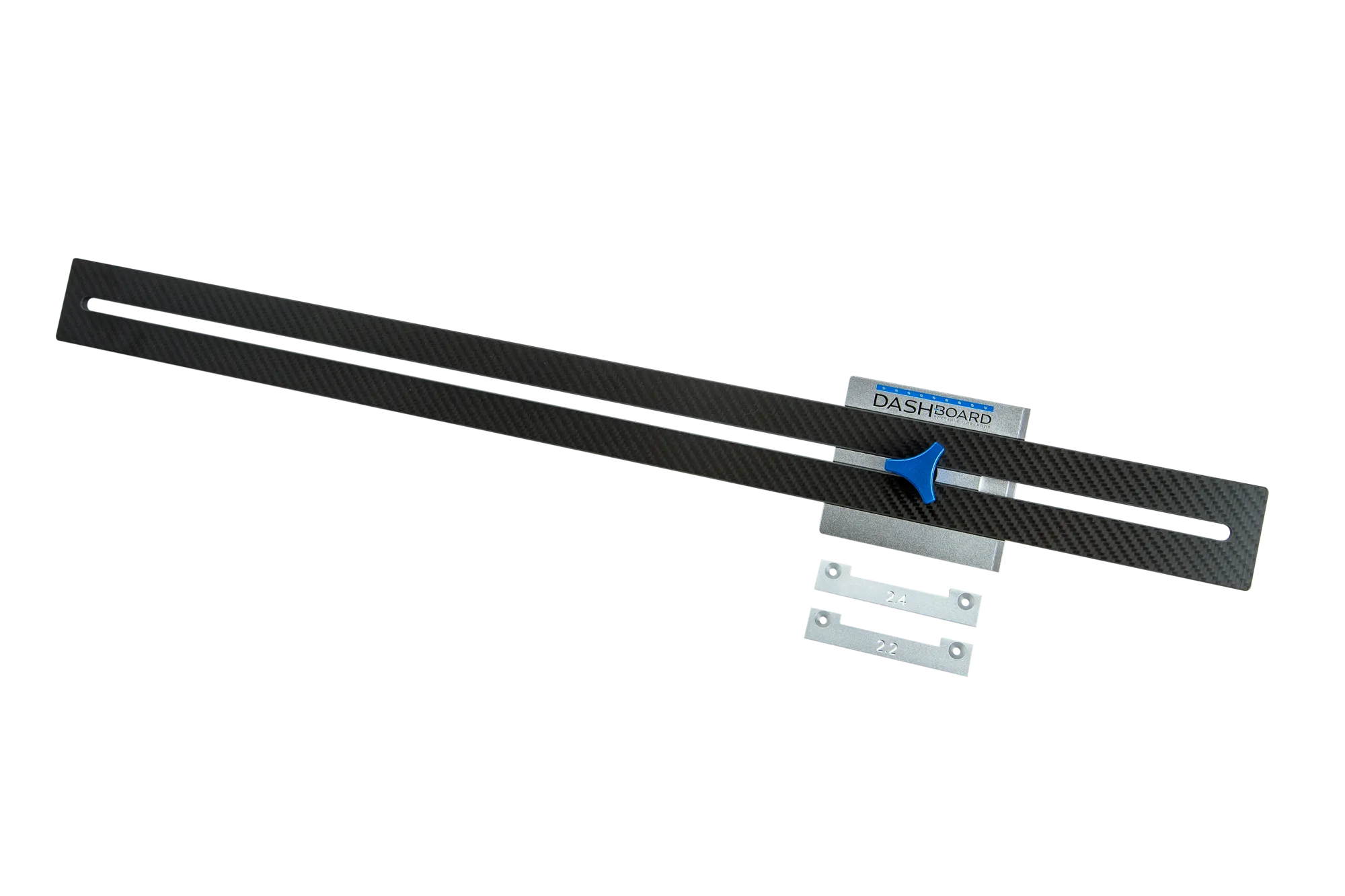TL;DR
- Weight difference: Crosscut sleds (10-40 lbs) vs portable workbenches using track saw setup (15-25 lbs combined)
- Space savings: Fixed sleds require 6-12 sq ft permanent storage; portable benches fold to 4" thick
- Setup time: 30 seconds for portable bench vs 5-10 minutes mounting/aligning sled
- Material capacity: Handle full 4x8 sheets vs table saw's 24-30" crosscut limit
- Cost comparison: $1,500-2,000 portable system replaces $3,000+ in specialized jigs
- Best for: Small shops, mobile contractors, and anyone cutting sheet goods regularly
The 60-Second Setup That's Killing the Crosscut Sled
Watch a contractor unfold a portable workbench, lock the legs, and start cutting in just minutes. Now watch someone mount a 40-pound crosscut sled, check alignment, clear the outfeed space, and realize they need help moving a full sheet of plywood.
That daily friction explains why crosscut sleds are gathering dust while portable workbenches dominate job sites.
The numbers tell the story: A traditional crosscut sled weighs 30-50 pounds and eats up 6-12 square feet of wall space.
A portable workbench like the Dash-Board system weighs 62 pounds total, folds to 3.5 inches thick, and handles materials a table saw can't touch—full 4x8 sheets with crosscuts up to 48 inches.
The Space Problem Nobody Talks About
Fixed Jig Storage Reality
Every crosscut sled needs dedicated storage. Mount it on the wall? That's prime real estate gone. Stack it in a corner? Now it's a dust collector. The average two-car garage workshop loses 15% of usable space to jig storage alone.
Portable workbenches solve this by becoming their own storage.
The Dash-Board Workbench folds to 92" x 24" x 3.5"—thin enough to slide behind a door or hang on a wall. When you need it, the adjustable legs deploy in seconds, creating a 35.5 inch high work surface that's more stable than most permanent benches.
The Track Saw Revolution
Track saws changed everything. Pair one with a portable workbench, and you get:
- Splinter-free cuts without zero-clearance inserts
- No kickback risk from trapped offcuts
- Cutting capacity limited only by rail length (up to 100" rips possible)
- Dust collection that actually works (up to 90% capture with proper setup)
Real Numbers: Time and Money

Setup Time Comparison
Crosscut sled workflow (5-10 minutes):
- Clear table saw surface
- Remove blade guard/riving knife
- Mount sled (two-person job for large sleds)
- Check square with test cuts
- Adjust fence if needed
Portable workbench workflow (1-2 minutes):
- Unfold bench
- Lock legs
- Place track saw guide
- Cut
Engineering Advantages Most People Miss
Weight Distribution
Fixed sleds concentrate weight at the table saw, creating tipping hazards with large panels. Portable workbenches distribute weight across four points, with adjustable legs compensating for uneven floors (+1 inch adjustment range typical).
Precision Without Complexity
Modern portable benches use CNC-machined tops with 20mm hole patterns accurate to ±0.1mm. The Dash-Board's replaceable cut strip means you never lose accuracy to blade kerf wear—flip it for a fresh edge, replace it when both sides wear.
Material Support
Crosscut sleds require more elaborate structures to adequately support material across their entire length/width, and may require two operators. Portable workbenches support the entire panel, reducing flex/tilt and improving cut quality, making a single operator’s job simpler. Add accessories like Track Stars and you extend support ~12 inches beyond the bench edge.
Solving Real Job Site Problems
The Plywood Problem
Contractor reality: You're cutting drawer boxes from ¾" plywood. With a crosscut sled, you need:
- Helper to support the sheet
- Multiple passes to break down material
- Space to maneuver 4x8 sheets around the saw
With a portable bench and track saw:
- Cut solo with full sheet supported
- Make all cuts where the material sits
- No lifting 50-pound sheets onto the saw
The Repeat Cut Solution

Traditional approach: Set up stop blocks on the sled, hope they don't shift, measure constantly.
Portable bench approach: Use integrated fence systems with flip stops. The Rip Gauge accessory sets dimensions including blade kerf—measure once, cut identically every time.
When Fixed Jigs Still Make Sense
Crosscut sleds aren't dead. They excel at:
- Specialty angles with dedicated jigs
- Production runs of identical parts
- Shops with permanent table saw stations
But for sheet goods, varying locations, and modern workflows, portable systems win.
Making the Transition
Week 1-2: Learning Curve
- Practice cuts with track saw
- Master the guide rail alignment
- Understand accessory placement
Week 3-4: Building Confidence
- Attempt complex cuts (45° bevels, long rips)
- Experiment with different materials
- Develop your setup routine
Month 2: Full Integration
- Retire the crosscut sled for most tasks
- Optimize accessory configuration
- Track time savings
Choosing the Right System
Essential Features
- Hole pattern: 96mm on center standard for accessory compatibility
- Weight capacity: Minimum 200 lbs for contractor use
- Leg adjustment: At least 1" range for uneven surfaces
- Surface size: 24" width minimum for stable sheet support
Build Quality Markers
- Aluminum extrusion frames (not steel tube)
- Replaceable wear surfaces
- Metal adjustment knobs (not plastic)
- CNC-machined tolerances
FAQ on Crosscut Sled Alternatives
Can a portable workbench really replace my crosscut sled?
For 90% of crosscutting tasks, yes. Sheet goods and anything requiring mobility work better on portable systems. Keep your sled for specialized small parts work.
What about accuracy compared to a well-tuned sled?
Modern portable benches achieve ±0.5mm accuracy over 8 feet when properly set up. The Dash-Board system's machined holes ensure repeatable setups.
How do portable benches handle heavy materials?
Load ratings vary from 100-400 pounds. The Dash-Board supports 400 pounds static load. For comparison, a full sheet of ¾" plywood weighs about 60 pounds.
Is the track saw mandatory?
While circular saws work with guide rails, track saws offer superior dust collection, splinter-free cuts, and safety features. The investment ($400-700) pays off in material savings and cut quality.
What about cutting small pieces safely?
Both systems handle small pieces effectively. It can be argued that using a track saw is actually safer for small parts because the blade retracts into the saw when a cut is finished and there’s no concern about pulling cut pieces back past the blade, as would be typical with a table saw.
How long do portable workbenches last?
Quality aluminum-frame benches show minimal wear after 5+ years of contractor use. Replaceable components (cut strips, bench tops) extend lifespan indefinitely. Compare to MDF sleds that warp and wear within 2-3 years.
The shift from fixed jigs to portable systems reflects modern woodworking reality: smaller shops, mobile work, and versatile tools that justify their space. While crosscut sleds served admirably for decades, portable workbenches now offer a more practical solution for most woodworkers' daily needs.











